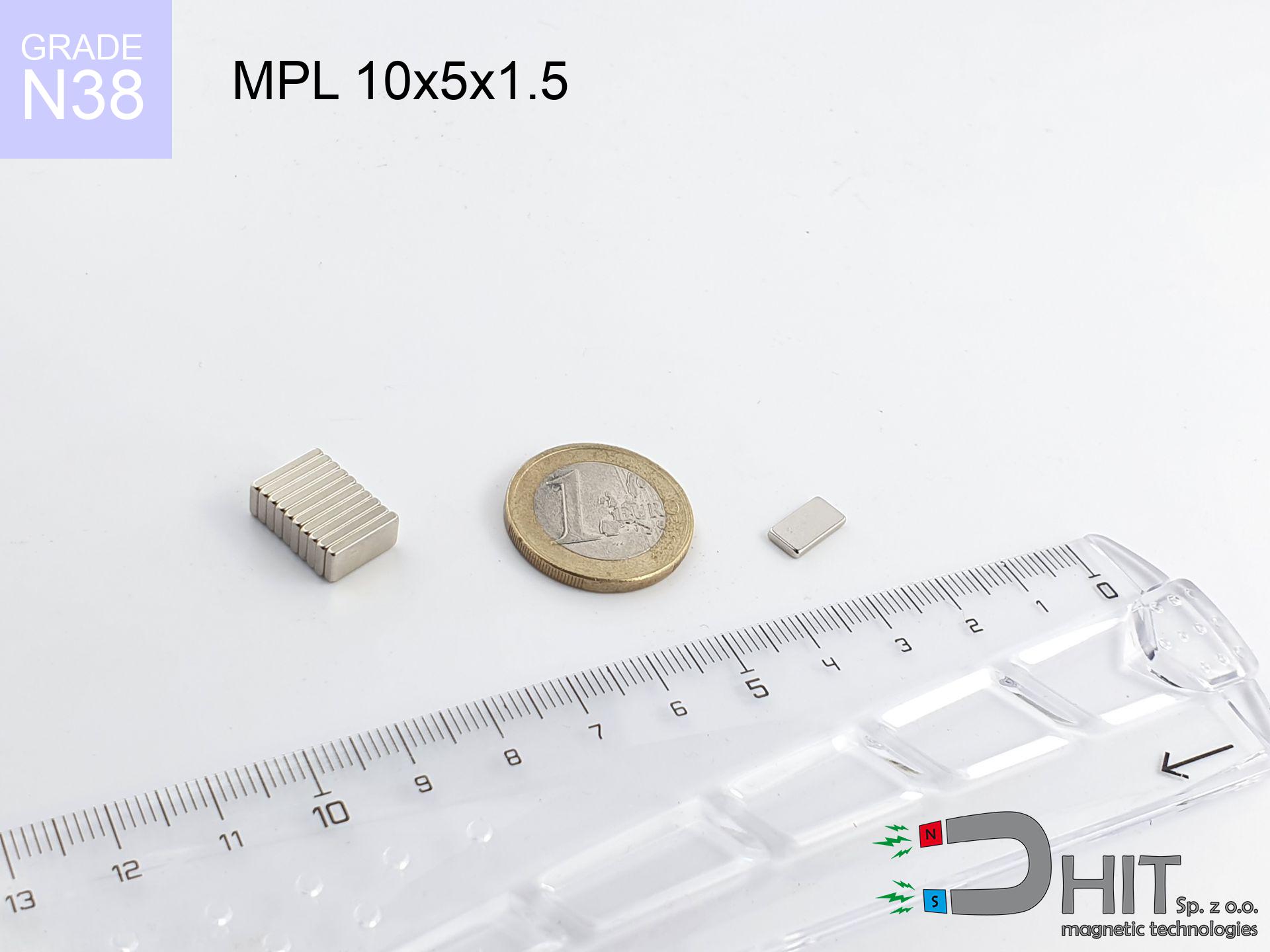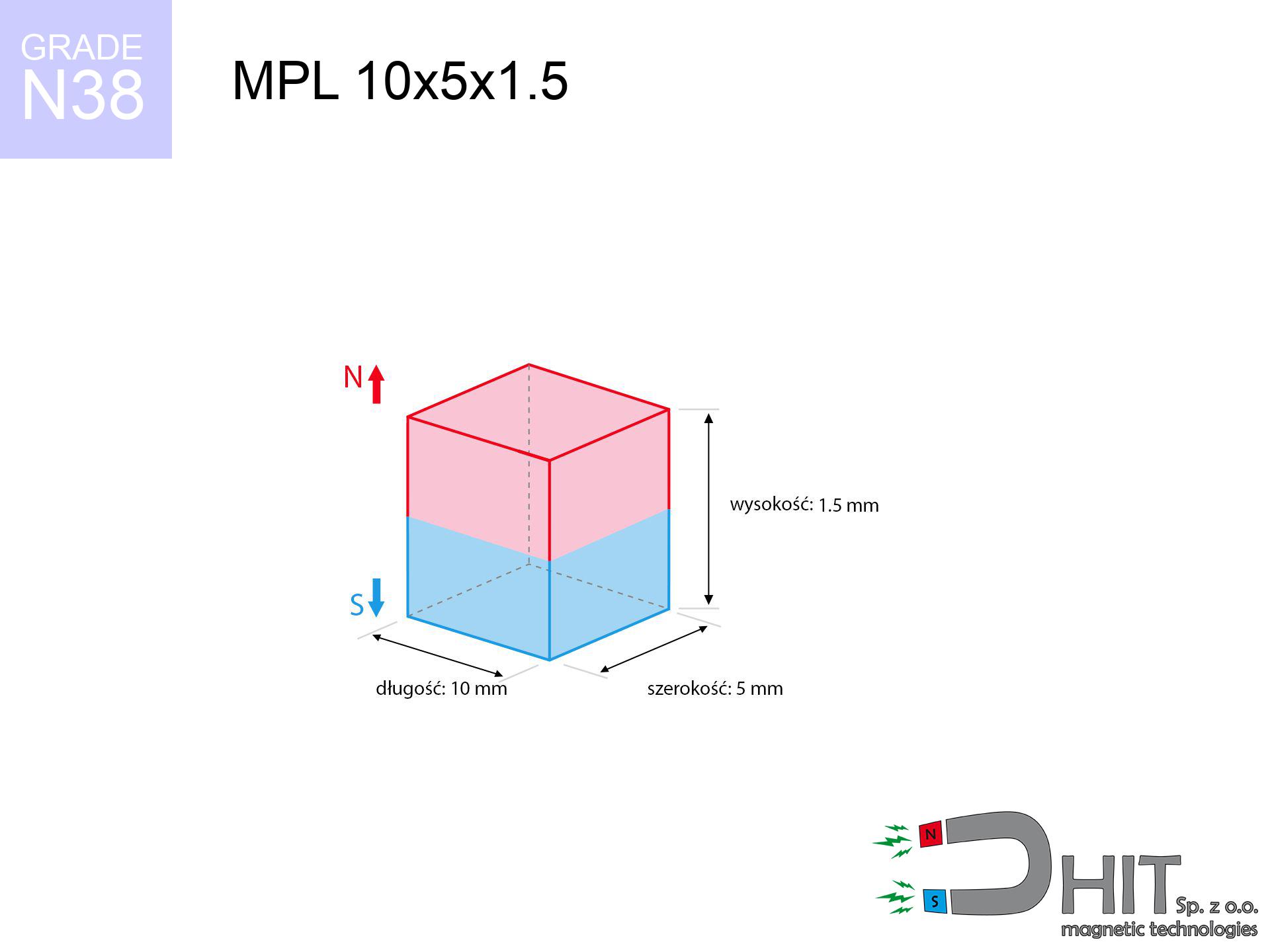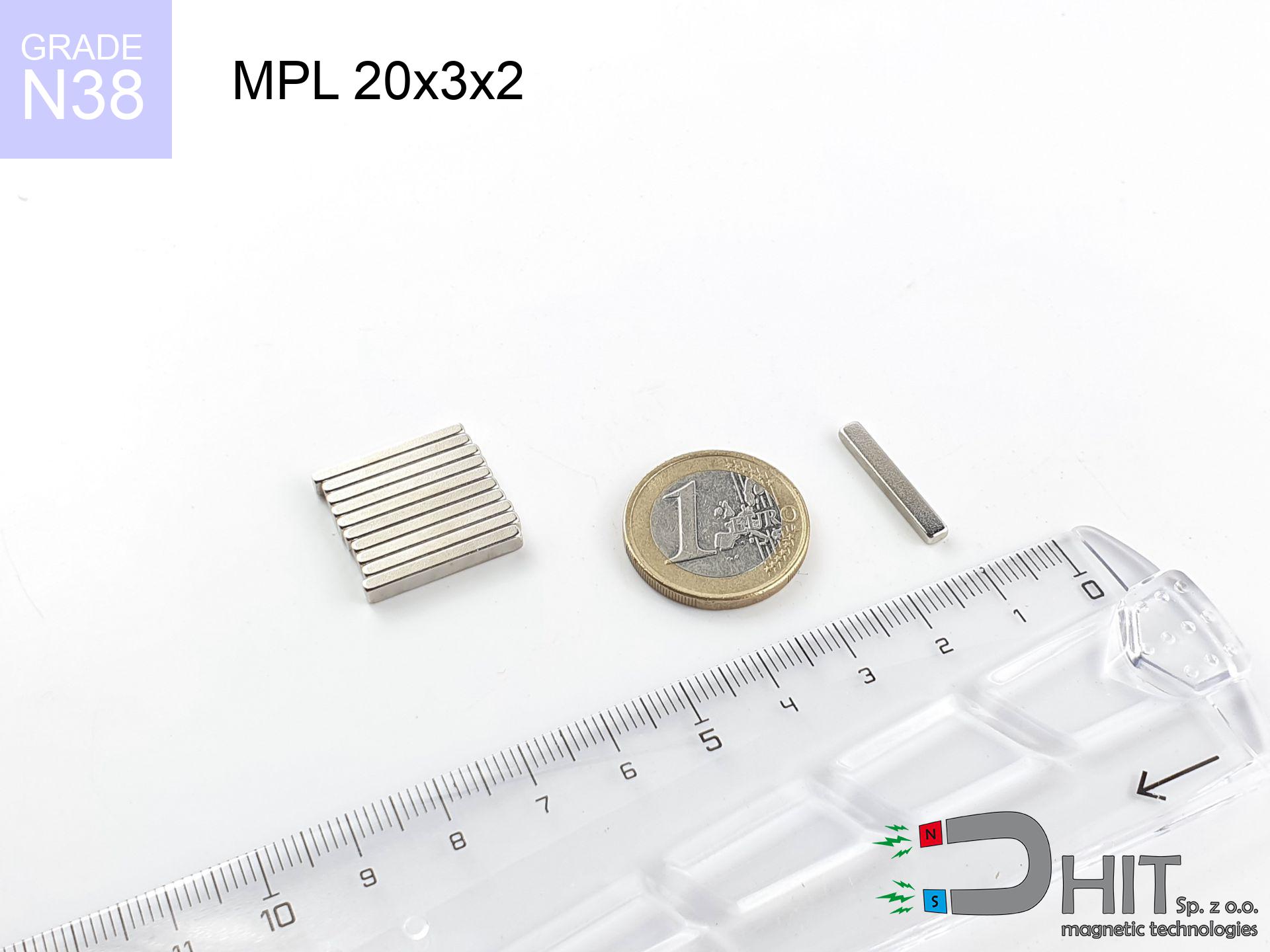MPL 10x5x1.5 / N38 - neodymium magnet
lamellar magnet
catalog number 020114
GTIN: 5906301811206
length
10
mm [±0,1 mm]
width
5
mm [±0,1 mm]
height
1.5
mm [±0,1 mm]
magnetizing direction
↑ axial
capacity ~
0.84 kg / 8.24 N
magnetic induction ~
239.33 mT / 2,393 Gs
max. temperature
≤ 80
°C
catalog number 020114
GTIN: 5906301811206
length
10 mm [±0,1 mm]
width
5 mm [±0,1 mm]
height
1.5 mm [±0,1 mm]
magnetizing direction
↑ axial
capacity ~
0.84 kg / 8.24 N
magnetic induction ~
239.33 mT / 2,393 Gs
max. temperature
≤ 80 °C
0.46 ZŁ gross price (including VAT) / pcs +
0.37 ZŁ net price + 23% VAT / pcs
bulk discounts:
need more quantity?Don't know what to buy?
Give us a call tel: +48 22 499 98 98 or get in touch via form on our website. You can check the lifting capacity as well as the shape of neodymium magnet in our magnetic mass calculator force calculator
Orders placed by 2:00 PM will be shipped on the same business day.
Specification: lamellar magnet 10x5x1.5 / N38 ↑ axial
Magnetic properties of the material N38
Physical properties of sintered neodymium magnets Nd2Fe14B
Contact Surface: Thanks to their flat shape, disc magnets guarantee a larger contact surface with other elements, which can be beneficial in applications requiring a stronger magnetic connection.
Applications in Technology: The magnets are often utilized in many devices, such as sensors, stepper motors, or speakers, where a flat shape is important for their operation.
Mounting: Their flat shape makes mounting, particularly when there's a need to adhere the magnet to another surface.
Design Flexibility: The disc shape of the magnets gives designers with significant flexibility in arranging them in devices, which can be more difficult with magnets of other shapes.
Stability: In some applications, the flat base of a disc magnet may offer better stability, reducing the risk of sliding or rotating. However, it's important to remember that the optimal shape of a magnet is dependent on the particular use and requirements. In some cases, other shapes, such as cylindrical or spherical, might be a better choice.
Product suggestions
Advantages as well as disadvantages of neodymium magnets NdFeB.
Apart from immense power, neodymium magnets have the following advantages:
- They do not lose strength over time. After approximately 10 years, their power decreases by only ~1% (theoretically),
- They are exceptionally resistant to demagnetization caused by an external magnetic field,
- In other words, thanks to the shiny nickel, gold, or silver finish, the element gains an visually attractive appearance,
- They have exceptionally high magnetic induction on the surface of the magnet,
- By using an appropriate combination of materials, they can achieve significant thermal resistance, allowing them to operate at temperatures up to 230°C and above...
- Due to the option of accurate forming and adaptation to individual needs – neodymium magnets can be produced in various forms and dimensions, which amplifies their universality in usage.
- Wide application in modern technologies – find application in computer drives, electric motors, medical devices or very modern machines.
Disadvantages of neodymium magnets:
- They are fragile when subjected to a strong impact. If the magnets are exposed to impacts, we recommend using magnets in a protective case. The steel housing in the form of a holder protects the magnet from impacts, and at the same time increases its overall strength,
- Magnets lose their strength due to exposure to high temperatures. In most cases, when the temperature exceeds 80°C, these magnets experience permanent reduction in strength (although it is worth noting that this is dependent on the form and size of the magnet). To avoid this problem, we offer special magnets marked with the [AH] symbol, which exhibit high temperature resistance. They can operate even at temperatures as high as 230°C or more,
- Due to their susceptibility to corrosion in a humid environment, we recommend using waterproof magnets made of rubber, plastic, or other moisture-resistant materials when using them outdoors,
- Limited ability to create threads or complex shapes in the magnet - the use of a housing is recommended - magnetic holder
- Potential hazard associated with microscopic parts of magnets are risky, when accidentally ingested, which is crucial in the context of children's health. Furthermore, tiny parts of these products can be problematic in medical diagnosis when they are in the body.
Exercise Caution with Neodymium Magnets
It is crucial not to allow the magnets to pinch together uncontrollably or place your fingers in their path as they attract to each other.
If you have a finger between or alternatively on the path of attracting magnets, there may be a large cut or a fracture.
Neodymium magnets should not be near people with pacemakers.
Neodymium magnets generate strong magnetic fields. As a result, they interfere with the operation of a pacemaker. This is because many of these devices are equipped with a function that deactivates the device in a magnetic field.
Avoid bringing neodymium magnets close to a phone or GPS.
Neodymium magnets are a source of intense magnetic fields that cause interference with magnetometers and compasses used in navigation, as well as internal compasses of smartphones and GPS devices.
Neodymium magnets can become demagnetized at high temperatures.
Although magnets have shown to retain their effectiveness up to 80°C or 175°F, this temperature may vary depending on the type of material, shape, and intended use of the magnet.
Dust and powder from neodymium magnets are highly flammable.
Do not attempt to drill into neodymium magnets. Mechanical processing is also not recommended. Once crushed into fine powder or dust, this material becomes highly flammable.
Neodymium magnets are characterized by being fragile, which can cause them to become damaged.
Neodymium magnets are highly delicate, and by joining them in an uncontrolled manner, they will crack. Magnets made of neodymium are made of metal and coated with a shiny nickel, but they are not as durable as steel. In the event of a collision between two magnets, there may be a scattering of fragments in different directions. Protecting your eyes is crucial in such a situation.
Magnets should not be treated as toys. Therefore, it is not recommended for youngest children to have access to them.
Neodymium magnets are not toys. You cannot allow them to become toys for children. In such a situation, surgery is necessary to remove them. In the worst case scenario, it can result in death.
Keep neodymium magnets away from TV, wallet, and computer HDD.
The strong magnetic field generated by neodymium magnets can damage magnetic media such as floppy disks, video tapes, HDDs, credit cards, magnetic ID cards, cassette tapes, or other devices. They can also destroy videos, televisions, CRT computer monitors. Do not forget to keep neodymium magnets away from these electronic devices.
Neodymium magnets are the strongest magnets ever invented. Their strength can surprise you.
Make sure to review all the information we have provided. This will help you avoid harm to your body and damage to the magnets.
The magnet coating is made of nickel, so be cautious if you have an allergy.
Studies show a small percentage of people have allergies to certain metals, including nickel. An allergic reaction often manifests as skin redness and rash. If you have a nickel allergy, try wearing gloves or avoid direct contact with nickel-plated neodymium magnets.
So you are aware of why neodymium magnets are so dangerous, see the article titled How dangerous are strong neodymium magnets?.




![magnetic holder rubber internal thread 22x6 [M4] GW / N38 magnetic holder rubber internal thread 22x6 [M4] GW / N38](https://cdn3.dhit.pl/graphics/products/umg-22x6-m4-gw-jek.jpg)
![magnetic separator 25x100 [2xM8] / N42 magnetic separator 25x100 [2xM8] / N42](https://cdn3.dhit.pl/graphics/products/sm-25x100-2xm8-feg.jpg)


